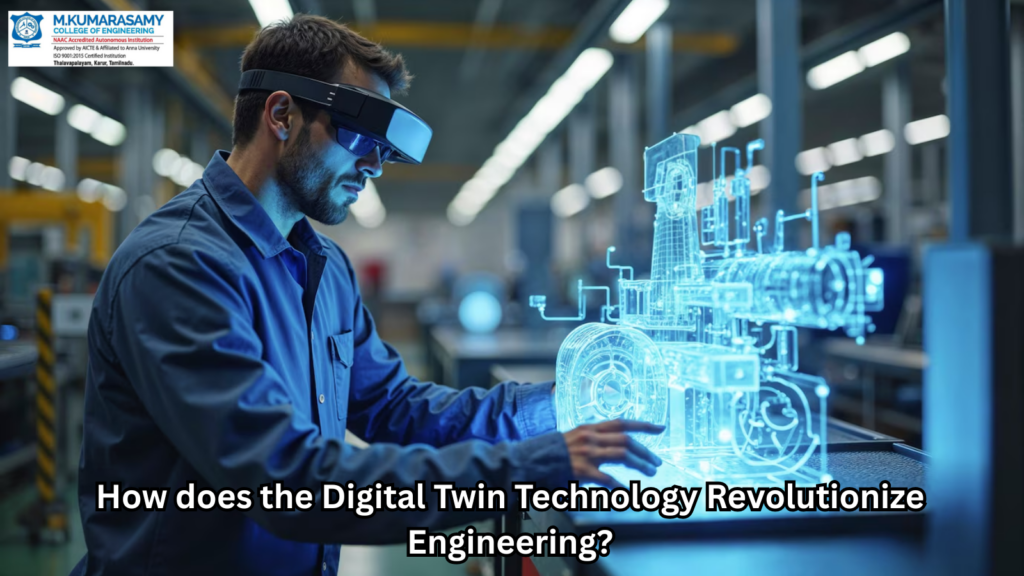Digital Twin Technology stands as a groundbreaking innovation reshaping the engineering domain. At M. Kumarasamy College of Engineering (MKCE), this transformative concept is taught with precision, preparing students to thrive in cutting-edge industries. With its unparalleled ability to simulate real-world objects, processes, and systems, Digital Twin Technology has swiftly become a cornerstone in modern engineering education and practice.
What is Digital Twin Technology?
It refers to the creation of a virtual replica or model of a physical entity. Engineers utilize this advanced simulation tool to monitor, analyze, and optimize the performance of assets in real time. Unlike static models, Digital Twin Technology integrates real-time data, predictive analytics, and advanced computing to deliver actionable insights. Furthermore, its applications extend across various engineering disciplines, making it an indispensable tool for students and professionals alike.
The Role of Digital Twin Technology in Engineering
- Enhancing Predictive Maintenance It enables engineers to anticipate equipment failures before they occur. By analyzing real-time data from sensors embedded in physical assets, engineers can identify patterns indicative of potential malfunctions. So, this proactive means of approach typically minimizes downtime, then reduces repair costs, and also extends the lifespan of machinery.
- Streamlining Design and Prototyping It revolutionizes the design process. Engineers can create virtual prototypes and test them under diverse conditions without physical trials. As a result, this accelerates development timelines, reduces costs, and ensures designs meet stringent standards before production.
- Optimizing Operations By mirroring the behavior of physical systems, Digital Twin Technology offers unparalleled insights into operational efficiencies. Moreover, engineers can tweak virtual models to test various scenarios, ensuring optimal performance while minimizing energy consumption and resource wastage.
- Fostering Innovation in Smart Manufacturing In the realm of Industry 4.0, Digital Twin Technology serves as a critical enabler of smart manufacturing. It connects physical systems to their digital counterparts, thereby facilitating seamless communication, adaptive decision-making, and enhanced productivity.
- Enabling Infrastructure Management From bridges to skyscrapers, Digital Twin Technology empowers civil engineers to monitor structural integrity continuously. By integrating sensor data, engineers can detect anomalies, predict maintenance needs, and enhance safety measures.
Applications of Digital Twin Technology in Engineering at MKCE
At MKCE, this technology is not just a theoretical concept but a practical tool shaping the next generation of engineers. Departments such as Mechanical, Civil, and Electrical Engineering incorporate this technology into their curriculum, emphasizing hands-on learning. Additionally, students gain expertise in:
- IoT Integration: Building IoT-enabled systems that synchronize physical and digital twins.
- Data Analytics: Utilizing Digital Twin Technology to analyze performance metrics and optimize processes.
- Virtual Reality (VR) Simulations: Combining VR with digital twins to visualize and interact with complex engineering systems.
- Sustainable Engineering Practices: Leveraging digital twins to design eco-friendly and resource-efficient solutions.
Real-World Examples of Digital Twin Technology

- Aerospace Engineering Leading companies like Boeing and NASA employ Digital Twin Technology to simulate aircraft performance. Engineers analyze flight dynamics, optimize fuel efficiency, and ensure safety standards using these virtual models.
- Automotive Innovation Tesla integrates Digital Twin tech to monitor vehicle health and improve autonomous driving features. Consequently, this continuous feedback loop enables rapid advancements in electric and autonomous vehicles.
- Urban Planning Smart cities utilize Digital Twin Technology to manage utilities, traffic systems, and urban development projects. Therefore, this innovation ensures sustainable growth and improves residents’ quality of life.
- Healthcare Devices In biomedical engineering, digital twins model patient-specific devices, ensuring precise customization and effective performance.
The Future of Digital Twin Tech in Engineering
Digital Twin tech is not static; it evolves alongside advancements in artificial intelligence, IoT, and data analytics. Thus, engineers of tomorrow will witness:
- Hyper-Accurate Simulations: With AI, digital twins will deliver predictions with unmatched precision.
- Autonomous Operations: Integration with machine learning will enable self-correcting systems.
- Global Connectivity: Enhanced IoT networks will allow real-time monitoring of assets worldwide.
- Green Engineering Solutions: Digital twins will play a pivotal role in achieving sustainability goals by minimizing environmental impact.
Why MKCE is the Right Place to Learn Digital Twin Tech
At M.Kumarasamy College of Engineering, students are immersed in a curriculum that bridges theory and practice. The institution’s state-of-the-art laboratories, industry collaborations, and experienced faculty ensure that graduates are equipped with the skills demanded by global employers. Moreover, MKCE fosters innovation, encouraging students to leverage Digital Twin Technology to solve real-world engineering challenges.
In addition, the college organizes workshops, hackathons, and industry seminars focused on Digital Twin Technology, ensuring students remain at the forefront of this technological revolution. By mastering Digital Twin Technology, MKCE students not only excel academically but also contribute to transformative engineering solutions.
Conclusion
Hence, Digital Twin Tech is revolutionizing engineering practices, making it an essential subject for aspiring engineers. Also, at MKCE, this innovative concept is taught with a focus on practical application and industry relevance. From predictive maintenance to smart manufacturing, the possibilities of Digital Twin Technology are vast and impactful. By embracing this technology, students at MKCE are poised to lead the engineering innovations of tomorrow, setting new benchmarks in excellence and sustainability. Undoubtedly, Digital Twin Technology is not just a tool; it is the future of engineering, and MKCE is proud to be at its forefront.

